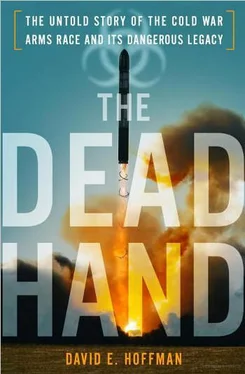———
When Shultz saw Gorbachev in Moscow in October, the Soviet leader seemed feisty, and there was more acrimony in their discussion than in the past. Shultz failed to secure agreement on a summit date to sign a treaty on intermediate-range weapons. Shultz wrote in his memoirs that Gorbachev appeared to have been through a tough period. 39In the days before Shultz arrived, Gorbachev had suffered a major crisis, an outbreak of open criticism in the Politburo. On October 21, Yeltsin, in a rushed, short speech before a Central Committee plenum, complained that reform was moving too slowly, and that Gorbachev was starting to enjoy the adulation of a “cult of personality,” a reference to Stalin. Yeltsin resigned on the spot from the Politburo. His speech and resignation stunned the hall. Gorbachev found himself squeezed between Yeltsin’s demands for faster reform and Politburo member Yegor Ligachev, who resisted it. 40Then, a few days after Shultz left Moscow, Gorbachev agreed to the summit dates. “The Soviets blinked,” Reagan wrote in his diary.
The yawning gulf of misunderstanding between Washington and Moscow had remained. Despite all that happened in 1987—the new military doctrine, the Rust affair and its aftermath, the abandonment of the Oka missile, the failure of the Soviet Star Wars, the achievement of eliminating the INF weapons–the Defense Intelligence Agency sent a report to Congress stating that “all evidence points to continuity in the Soviet Union’s military policy.” 41
Two weeks before Gorbachev arrived in the United States, Gates, the deputy CIA director, wrote a memo to Reagan about the Soviet leader that failed to grasp the essence of Gorbachev’s attempts to reverse the arms race, and miscast his goals and motivations. There is a “continuing extraordinary scope and sweep of Soviet military modernization and weapons research and development,” Gates said, offering not even a brief acknowledgment of Gorbachev’s efforts to change course. “We still see no lessening of their weapons production. And, further, Soviet research on new, exotic weapons such as lasers and their own version of SDI continues apace.” In fact, the Soviet version of SDI was a shambles and would never be built. Gates concluded that despite “great changes underway” in the Soviet Union, “it is hard to detect fundamental changes, currently or in prospect, in the way the Soviets govern at home or in their principle objectives abroad.” Gates told the president, amid the summit excitement, that “a sober–even somber—reminder of the enduring features of the regime and the still long competition and struggle ahead will be needed.” 42
Still, the December summit in Washington was far from somber, and crackled with energy. Gorbachev spontaneously stopped his limousine on Connecticut Avenue and began shaking hands with thrilled passersby. Reagan and Gorbachev signed the Intermediate-range Nuclear Forces treaty with a brisk exchange of pens and handshakes in a ceremony in the East Room of the White House. The treaty would eliminate 1,846 Soviet Pioneers and 846 American Pershing IIs, the first time in the nuclear age that an entire class of Soviet and U.S. weapons was wiped out, and under stringent verification provisions. It was not the end of nuclear danger, but it was the most concrete joint accomplishment of Reagan, the dreamer, and Gorbachev, the radical, nuclear abolitionists who found each other at the right moment. In remarks before they signed the treaty, Reagan said, “We have listened to the wisdom of an old Russian maxim, doveryai, no proveryai —trust, but verify.”
“You repeat that at every meeting,” Gorbachev said.
“I like it,” Reagan replied, smiling.
————— 13 —————
GERMS, GAS AND SECRETS
In the thick woods south of Moscow, at Obolensk, the microbiologist Igor Domaradsky redoubled his search for agents of death. He experimented with genetic engineering, combining the gene of diphtheria with the agents of plague or tularemia to make a hybrid pathogen. He turned his results over to the military, never to hear of them again. He labored to engineer a tularemia strain resistant to antibiotics. If used in a weapon, once spread, the disease would be difficult to treat. He created two strains that retained their virulence, but with only limited resistance to antibiotics. This was always the challenge—Domaradsky had never been able to achieve a high resistance and, simultaneously, sufficient virulence. If he got higher resistance, he got less virulence. One of the strains was tested on monkeys, but proved unsatisfactory. Domaradsky was adrift, and his conflict with the institute director, Nikolai Urakov, worsened as the months went by. Urakov blocked one of Domaradsky’s students from receiving a doctorate, questioned Domaradsky’s salary, gave Domaradsky piles of paperwork and insisted Domaradsky move out of his breezy flat in Protvino and into the dark woods at Obolensk. Domaradsky at one point took a daring step, writing a letter of complaint about Urakov to the Politburo. The letter resulted in an internal investigation and more conflict. Finally, Domaradsky asked to be transferred to another job in Moscow. He left Obolensk in the summer of 1987, having done much to launch the biological weapons program, but never to return.
Domaradsky thought his research on genetically modified agents fell short. He believed the search for a tularemia agent was a stopgap idea. It wasn’t contagious and the military wanted more virulent and dangerous pathogens that could spread. Overall, he said, “Very little was done to develop a new generation of these weapons, as had been the original goal” of the interagency council he had joined in Moscow in 1975. “I have to say that it has justified neither the hopes nor the colossal investment of material. Essentially nothing remarkable was ever produced…” 1
Domaradsky’s conclusion was premature. As he left, others took up the quest to create the agents of death.
In Domaradsky’s final year at Obolensk, a new scientist arrived. Sergei Popov was the bright young researcher who had worked on genetic engineering at Koltsovo, figuring out how to make the immune system turn on itself. At the time he arrived at Obolensk, the new building for working on dangerous pathogens was rising out of the forest. Popov recalled seeing Domaradsky roaming the halls, a bitter outcast. They did not talk. Popov believes he was brought in as Domaradsky’s successor in the intensifying search for genetically altered agents to be used in a biological weapon. When he departed Koltsovo in 1986, Popov turned over to other scientists his “construct,” the piece of DNA that would be inserted into a genome. Once at Obolensk, he began to look for ways to broaden his early discovery, using bacteria as the vehicle instead of viruses. “New, improved constructs had been provided to me in Obolensk,” he recalled. “My mission was to continue what had been started in Koltsovo.” The goal was to create agents with new and unusual characteristics, causing death in ways that would be unfathomable, and unstoppable.
For Popov, the Obolensk lifestyle seemed a welcome change from Koltsovo. With Moscow only an hour away, Popov drove north and loaded up his car with food and goods unknown in Koltsovo. But at work, Popov ran into resistance from Urakov, who was not pleased. “Urakov did not want me there,” Popov said. “Why would he? It was recognized that he had not kept up with the problem, and that microbiology was underdeveloped at the institute. Domaradsky also failed to meet the goal, and Biopreparat decided to assign a new person who would solve the problem. And imagine, a military general who was told something like this. He was against me from the very beginning! But Biopreparat insisted.”
Читать дальше












